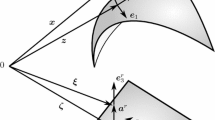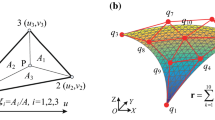Abstract
A refined geometrically nonlinear formulation of a thin-shell finite element based on the Kirchhoff-Love hypotheses is considered. Strain relations, which adequately describe the deformation of the element with finite bending of its middle surface, are obtained by integrating the differential equation of a planar curve. For a triangular element with 15 degrees of freedom, a cost-effective algorithm is developed for calculating the coefficients of the first and second variations of the strain energy, which are used to formulate the conditions of equilibrium and stability of the discrete model of the shell. Accuracy and convergence of the finite-element solutions are studied using test problems of nonlinear deformation of elastic plates and shells.
Similar content being viewed by others
References
S. Klinkel, F. Gruttmann, and W. Wagner, “A robust non-linear solid shell element based on a mixed variational formulation,” Comput. Meth. Appl. Mech. Eng., 195, 179–201 (2006).
V. V. Kuznetsov and I. F. Obraztsov, “Engineering applications of invariants in mechanics of thin-walled structures,” Izv. Ross. Akad. Nauk, Mekh. Tverd. Tela, No. 6, 132–140 (1993).
V. V. Kuznetsov and S. V. Levyakov, “Kinematic groups and finite elements in deformable body mechanics,” Izv. Ross. Akad. Nauk, Mekh. Tverd. Tela, No. 3, 67–82 (1994).
V. V. Kuznetsov and S. V. Levyakov, “Geometrically nonlinear models of flexible rods,” Construction Mechanics and Calculation of Buildings (collected scientific papers) [in Russian], No. 5 (1991), pp. 7–10.
S. P. Finikov, Course on Differential Geometry [in Russian], Gostekhteoretizdat, Moscow (1952).
V. V. Kuznetsov and Yu. V. Soinikov, “Strain analysis of shells for arbitrary displacements by the finite-element method,” Izv. Akad. Nauk SSSR, Mekh. Tverd. Tela, No. 1, 131–138 (1987).
O. Z. Zienkiewicz, The Finite Element Method, McGraw-Hill, London (1977).
V. V. Kuznetsov, “Recursive relations for the variation coefficients of the energy of nonlinear elastic systems,” Izv. Akad. Nauk SSSR, Mekh. Tverd. Tela, No. 4, 182–183 (1989).
V. V. Kuznetsov, “Determination of arbitrary rotations in nonlinear analysis of thin-walled structures,” in: Design of Structural Elements of Aircraft [in Russian], Mashinostroenie, Moscow (1990), pp. 59–63.
K. Y. Sze, X. H. Liu, and S. H. Lo, “Popular benchmark problems for geometric nonlinear analysis of shells,” Finite Elem. Anal. Des., 40, No. 11, 1551–1569 (2004).
A. S. Vol’mir, Stability of Deformable Systems [in Russian], Nauka, Moscow (1967).
V. V. Kuznetsov and S. V. Levyakov, “Analysis of nonlinear solutions with many singular points in problems of spatial deformation of rods,” J. Appl. Mech. Tech. Phys., 39, No. 6, 949–954 (1998).
Author information
Authors and Affiliations
Additional information
__________
Translated from Prikladnaya Mekhanika i Tekhnicheskaya Fizika, Vol. 48, No. 5, pp. 160–172, September–October, 2007.
Rights and permissions
About this article
Cite this article
Kuznetsov, V.V., Levyakov, S.V. Refined geometrically nonlinear formulation of a thin-shell triangular finite element. J Appl Mech Tech Phys 48, 755–765 (2007). https://doi.org/10.1007/s10808-007-0098-4
Received:
Revised:
Issue Date:
DOI: https://doi.org/10.1007/s10808-007-0098-4




